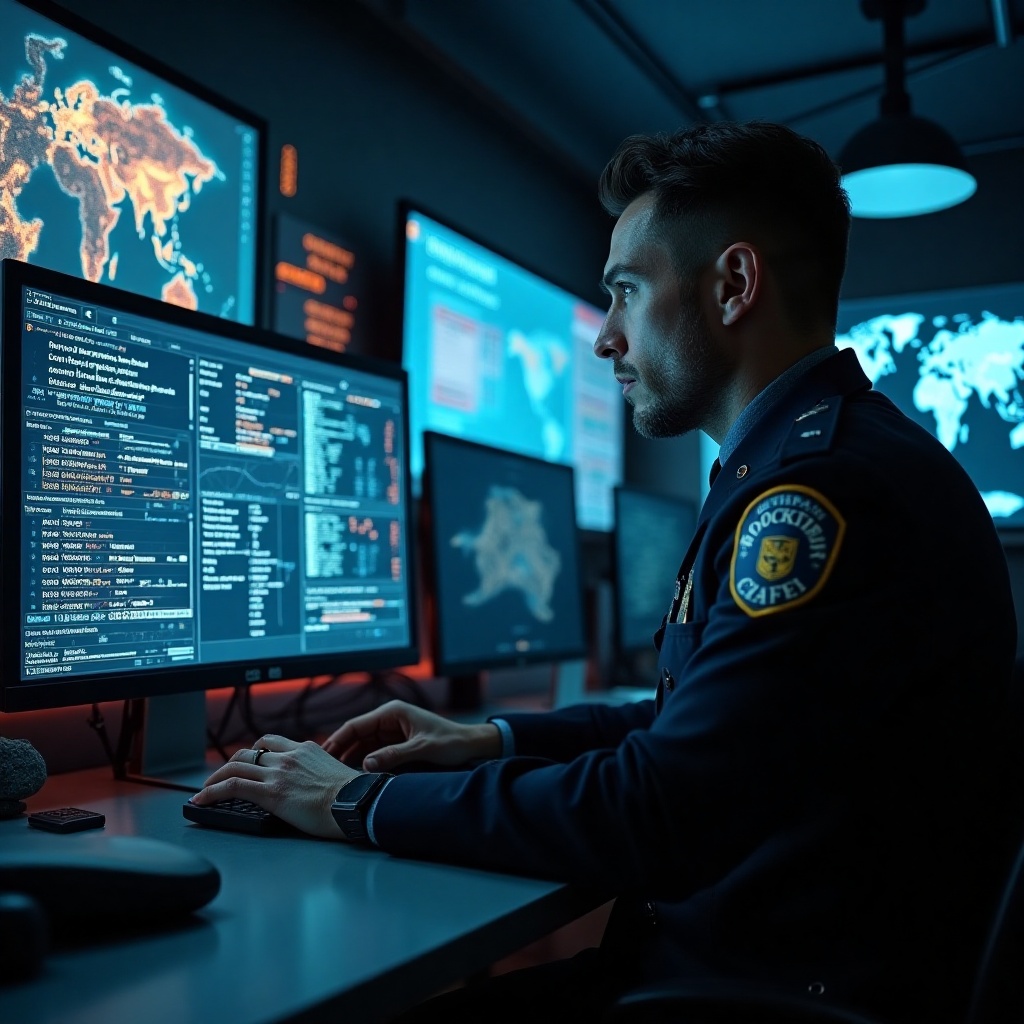Cryptocurrency is no longer the fringe experiment it once was. What began as a decentralized movement to democratize finance has matured into a trillion-dollar global ecosystem. Governments recognize it. Financial institutions embrace it. Retail investors trade it daily. But alongside its rapid mainstream adoption, a darker narrative has unfolded.
Criminal organizations have seized upon the anonymity, speed, and borderless nature of digital currencies to fund illegal operations, evade sanctions, launder dirty money, and conceal their tracks. From high-profile ransomware attacks like Colonial Pipeline to the thriving economies of darknet markets, crypto has become the new cash—digital, discreet, and dangerously efficient.
For law enforcement, this presents a stark reality: traditional investigative models weren’t built for this. Crypto doesn’t move through banks. It doesn’t need IDs, passports, or real names. Instead, it flows through alphanumeric wallet addresses and cryptographic signatures embedded on blockchain networks. On the surface, these ledgers are transparent—every transaction is publicly recorded. But transparency doesn’t equal clarity. Decoding blockchain activity is like reading a foreign language without knowing the grammar.
This is why blockchain forensic tools are no longer optional—they’re essential. These are the investigative microscopes of the digital age. With them, investigators can trace the path of stolen assets, identify patterns of illicit movement, link suspicious wallets to known entities, and ultimately build airtight cases that stand up in court.
But these tools don’t operate in a vacuum. The ability to turn raw data into legal evidence demands a unique blend of technology, legal precision, ethical foresight, and investigative skill. Chain of custody must be maintained. Evidence must be court-admissible. Investigations must respect privacy laws and cross-border legal frameworks. And most importantly, officers must know how to use these tools with confidence, context, and clarity.
This article serves as your map through this complex terrain. We’ll begin by demystifying the concept of blockchain forensics, then walk through the technical and legal benchmarks any tool must meet to be credible. We’ll explore the top platforms trusted by law enforcement globally—what they do, how they work, and where they’ve succeeded. Finally, we’ll examine how agencies can train their teams, adapt to future threats, and ensure their strategies remain as dynamic as the digital adversaries they face.
This isn’t just about tracking coins—it’s about defending public safety in an era where money moves faster than bullets, and evidence is written in code.
Understanding Blockchain Forensics
At its core, blockchain forensics is the discipline of tracking, analyzing, and interpreting data stored on blockchain networks to uncover the identities, behaviors, and intentions of those transacting within them. It is a blend of digital investigation, data science, and financial intelligence—and for law enforcement, it has become a vital weapon in the fight against cybercrime.
Every transaction on a blockchain is permanent and public. But wallet addresses—strings of letters and numbers—hide the identities behind them. Criminals take advantage of this pseudonymity, scattering funds across hundreds of addresses and tokens, often using automated tools to make their financial trails as convoluted as possible.
Core Techniques in Blockchain Forensics
Transaction Tracing: Allows investigators to follow the movement of funds step by step. Essential for ransomware, scams, and theft.
Wallet Clustering: Groups wallet addresses likely controlled by the same actor based on transaction behaviors and technical patterns.
Cross-Chain Analysis: Tracks funds across multiple blockchains, critical in an era where funds often jump from Ethereum to Binance to Monero.
Mixer and Privacy Protocol Detection: Identifies when criminals use obfuscation tools like mixers or privacy coins to hide the source of funds.
Entity Attribution: Links wallet addresses to real-world actors using known tags, open-source intelligence, subpoenaed exchange records, and behavioral analysis.
Legal Considerations
Blockchain evidence must be handled with the same care as traditional forensic evidence:
- Chain of custody must be documented.
- Methods must be reproducible and court-defensible.
- Analysts must be trained to explain forensic findings clearly to judges and juries.
- Forensic work done without attention to legal standards risks being inadmissible—or worse, leading to wrongful conclusions.
Criteria for Selecting Blockchain Forensic Tools
Choosing a forensic tool isn’t a procurement task—it’s a tactical decision. The wrong tool could mean missed evidence or faulty conclusions. The right one becomes a trusted investigative partner.
Key Criteria Include:
- Accuracy & Reliability: Every trace must reflect the truth of the ledger.
- Cross-Chain Compatibility: Ability to follow funds as they move between tokens and networks.
- User Interface & Usability: Visualizations and simple workflows for investigators, not just engineers.
- Legal Reporting Capabilities: Tools must produce court-ready documentation, charts, and logs.
- System Integration: Export formats, API access, and teamwork support.
- Support & Training: Real-time vendor assistance during investigations and ongoing learning resources.
- Regulatory & Ethical Alignment: Tools must respect privacy laws, support auditability, and avoid “black box” results.
In short, a good tool helps you see more, faster, and with legal precision.
Top Blockchain Forensic Tools for Law Enforcement
These are not just software platforms—they are operational partners in the fight against digital crime.
Chainalysis Reactor
- Trusted by global agencies, including the FBI, DEA, and Europol.
- Tracks real-time transactions and supports over 100 blockchains.
- Known for robust evidence export, legal defensibility, and expert support.
- Used to recover Colonial Pipeline ransomware payments.
TRM Labs
- Strong in cross-chain and DeFi analytics.
- Supports 30+ blockchains.
- Ideal for AML-focused investigations and compliance integration.
- Used in terrorist financing investigations with international partners.
Elliptic Navigator
- Extensive risk scoring with integrated sanctions and watchlist data.
- Strong in DeFi and NFT analytics.
- Well-suited for European and international financial investigations.
CipherTrace
- Owned by Mastercard.
- Excellent AML capabilities and privacy coin monitoring.
- Used in trafficking, corruption, and large-scale fraud investigations.
Crystal Blockchain
- Accessible and effective for smaller agencies or fast-turnaround cases.
- Focused on ransomware and darknet wallet tracking.
- Strong visualization tools and behavioral tagging.
Each tool has strengths. The right one depends on your jurisdiction, budget, training level, and mission.
Legal and Ethical Considerations in Blockchain Forensics

Admissibility
Blockchain analysis must:
- Maintain data integrity.
- Be traceable through chain of custody.
- Be reproducible and explained clearly.
- Be relevant to the legal matter at hand.
Privacy and Ethics
Even public ledgers deserve private treatment when it comes to behavioral surveillance. Investigators must avoid:
- Overreach.
- Dragnet analysis without cause.
- Mislabeling innocent addresses.
Jurisdictional Issues
Investigating a wallet used in one country by a citizen of another, with an exchange in a third, can be legally complex. Agencies must cooperate under MLATs, international task forces, and transnational protocols to share evidence lawfully.
The foundation of blockchain forensics isn’t code. It’s trust—trust that what’s discovered was obtained, handled, and interpreted correctly.
Training and Capacity Building for Law Enforcement
Without training, the best forensic tools gather digital dust. Officers must be:
- Taught blockchain fundamentals.
- Trained in forensic platforms and methodologies.
- Prepared to testify about findings in court.
- Informed on crypto laws, privacy rights, and international cooperation.
Effective Training Models Include:
- Vendor-led certification programs.
- Scenario-based simulations.
- Internal academies and task force workshops.
Why It Matters:
- Keeps pace with criminal tactics.
- Ensures evidence survives legal scrutiny.
- Enables rapid response in active threats (e.g., live ransomware attacks).
Blockchain crime is no longer rare. It’s routine. Agencies must make blockchain training a core part of modern law enforcement education.
Future Trends in Blockchain Forensics
The next generation of crypto crime—and forensic response—will look different.
Key Trends:
- Cross-Chain Criminal Activity: Tools must track across multiple ledgers and asset types.
- AI-Driven Analysis: Predictive models will augment human judgment—but must remain explainable.
- Smart Contract and DeFi Forensics: Analysts will need to understand custom contract behavior and protocol vulnerabilities.
- NFT Fraud and Metadata Laundering: Investigators will trace not just currency, but content.
- Privacy Tech Arms Race: Mixers, stealth addresses, and zero-knowledge proofs will demand new tracing methods.
- Global Legal Convergence: FATF standards, MiCA regulation, and DOJ crypto enforcement are creating a unified framework.
What Law Enforcement Must Do:
- Future-proof their tools and skills.
- Invest in AI-aware training.
- Collaborate across borders and sectors.
- Anticipate rather than react.
In short, the future of blockchain forensics isn’t just about following the money—it’s about understanding how money moves when nobody’s watching.
Final Thought
The blockchain revolution has arrived—and so have the criminals. But so have you.
With the right forensic tools, ethical standards, and trained professionals, law enforcement can not only trace digital footprints but pursue justice in the very places criminals thought they were invisible.
This article has laid out the path: understand the forensic science, choose your tools carefully, train your people thoroughly, and prepare for a future where cryptocurrency is not the side story—but the scene of the crime.
Now, it’s time to lead. Because justice doesn’t stop at the edge of the blockchain—and neither should you.




